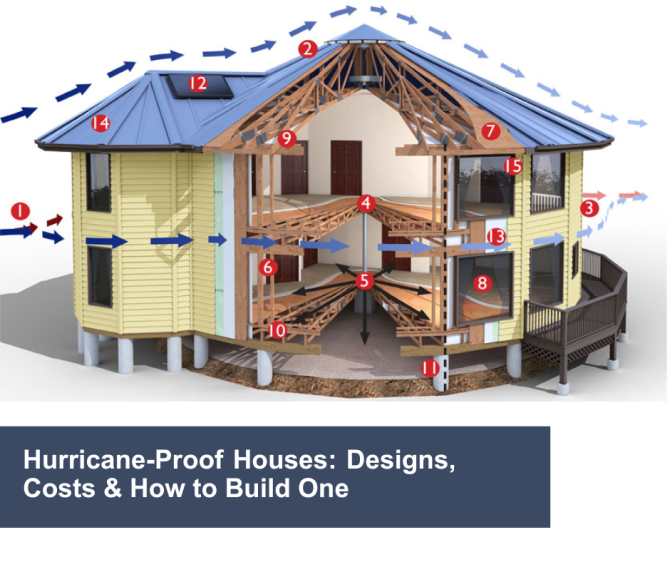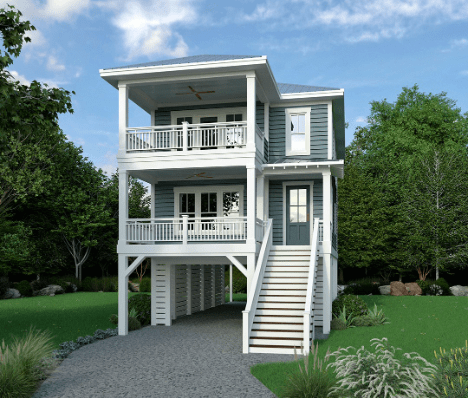When strong storms hit, homes in coastal areas take the worst of it. A hurricane-proof house can stand up to the wind, rain, and flying debris that destroy weaker homes. If you live in a hurricane-prone area, think about building one. This guide explains how to build a hurricane-proof house, what it costs, and how to strengthen your current home.

What Makes a House Hurricane-Proof?
A hurricane-proof house is built to withstand a storm. This means it must handle high winds and heavy rain, resist flooding, and protect the people inside. It uses smart hurricane-proof house design, strong materials, and solid plans to do this.
Key features include:
-
Roofs shaped to reduce wind pressure
-
Strong walls that won't crack or blow apart
-
Doors and windows with impact-resistant glass
-
Elevated structures to avoid floodwater
-
Good drainage systems move water away from the home
Hurricane-Proof House Designs
Traditional vs. Modern Hurricane-Proof Houses
Older homes often lack the features needed to survive a big storm. Many were not designed for hurricanes. But a modern hurricane proof house uses better materials and design tricks that help it survive.
Modern hurricane proof house designs often include reinforced concrete walls, steel frames, and breakaway ground floors. These homes also sit on raised foundations to avoid flood damage.
Essential Design Elements
No matter the style, all hurricane proof house designs should focus on:
-
A strong roof connection to the walls
-
Simple shapes to cut wind resistance
-
Small or no overhangs
-
Window protection with shutters or strong glass
-
A layout that keeps the structure tight and stable

Popular Architectural Styles for Hurricane-Prone Areas
Some styles work better than others. For example:
-
Elevated beach houses
-
Dome-shaped homes that allow wind to pass over
-
Square or rectangular homes with hip roofs
Each of these styles helps lower wind pressure and protect the home from damage.
Hurricane-Proof House Plans & Cost Breakdown
Hurricane-proof house plans range from small, affordable homes to large custom builds. The cost depends on size, materials, and location. On average, you might spend:
-
$250 to $350 per square foot for a basic hurricane-resistant home
-
More for custom designs with top-tier materials
A low cost hurricane proof house may use modular or prefab methods. These homes are often smaller, use cheaper materials, and are quicker to build.
Expect to budget for:
-
Land preparation and elevation
-
Special roofing materials
-
Impact windows and doors
-
Reinforced concrete or steel frames
-
Extra insurance costs
How to Build a Hurricane-Proof House?
Step 1: Choosing the Right Location
Don’t build near water unless you must. Choose higher ground if possible. Make sure the area has good drainage and follows local storm safety codes.
Step 2: Selecting the Best Materials
Use strong materials. Reinforced concrete, steel, and impact-rated windows are a must. Avoid wood that can rot or get eaten by pests.
Step 3: Building a Strong Foundation
This is key. A deep, solid foundation keeps the house from shifting or collapsing. Elevate the base if floods are a risk.
Step 4: Reinforcing Structural Components
Tie everything together roof, walls, and floor. Use hurricane straps and clips. Add extra nails or bolts where needed. This keeps the house tight and strong.
Step 5: Additional Protective Measures
Add storm shutters. Install sump pumps. Make sure your garage door can take pressure. Every small upgrade helps the house hold up better in a storm.
How to Hurricane-Proof Your Existing House?
Not everyone can start fresh. If you're upgrading a current home, focus on the most important parts:
-
Strengthen the roof-to-wall connections
-
Add impact-resistant windows and doors
-
Upgrade the garage door
-
Use sandbags or flood barriers around the foundation
-
Install a backup power system
These steps can make a big difference. You won’t match a full hurricane-proof house, but your home will be safer.
Conclusion: Wrapping It Up
A hurricane proof house isn't just a buzzword. It's a smart move if you live where storms hit hard. Whether you build from scratch or upgrade what you have, smart hurricane proof house design and planning matter. If you’re not sure where to start, check local rules or talk to a builder. A safe home isn’t out of reach. With the right plan, you can protect what matters.

